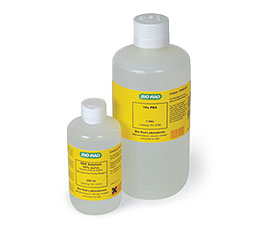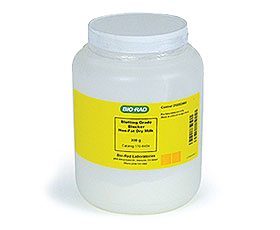Transfer Buffer for Western Blots
Since the first publication of a method for the electrophoretic transfer of proteins to nitrocellulose, the technique — now called western blotting — has become a standard method for detecting and quantifying proteins. The basic method of blotting and the composition of the standard western blot transfer buffer have not changed over the years.
Every western blot buffer must have two main properties: a western blot buffer must both promote the elution of proteins from the gel matrix and facilitate the efficient binding of all proteins in the sample to the membrane. Additionally, the components of a western blot buffer must not interfere with any subsequent steps after the transfer.
The advent of semi-dry blotting and the optimization of western blotting transfer for specific classes of proteins have resulted in several alternative formulations of western blot transfer buffers. Bio-Rad offers premixed blot buffers and reagents for use in common western blotting protocols.
Western Blot Transfer Buffer Formulations
The standard transfer buffer for western blots, called Towbin buffer, is 25 mM Tris, 192 mM glycine, pH 8.3 — usually with 20% methanol (vol/vol). Sometimes SDS is added to this buffer, generally in the range of 0.1 to 0.25%. This transfer buffer has both low ionic strength and low conductivity, which is optimal for tank (wet) blotting and for some semi-dry apparatuses.
Tris/glycine western blot buffer may not be suitable in some types of apparatuses for transfer of very high molecular weight proteins, which require lengthy transfer times. As transfer proceeds for an extended period of time, the production of heat decreases the resistance of standard western blot transfer buffer, causing the blot buffer to lose buffering capacity, thus reducing transfer efficiency. Additionally, the increased heat can cause gels to stick to the membrane, creating a handling problem for the soft, low-percentage acrylamide gels that are usually used for very high molecular weight proteins. Often, these gels must be carefully and laboriously scraped off the membrane.
For particular proteins, the choice of blot buffer can impact the efficacy of transfer. Generally acidic proteins are transferred more efficiently in a western blot buffer with a lower pH, and basic proteins are more efficiently transferred in a blot buffer with a higher pH. There are many buffers used for western blotting, such as the Dunn carbonate buffer (10 mM NaHCO3, 3 mM Na2CO3, pH 9.9); 10 mM CAPS, pH 11; and 10 mM CHES, pH 9.6.
For semi-dry western blotting, in addition to the standard Tris/glycine blot buffers, CAPS can be substituted for the glycine. A typical formulation has 60 mM Tris and 40 mM CAPS. An advantage of semi-dry blotting is that, unlike in tank blotting, the anode and cathode buffers are separated. This provides the ability to increase the efficiency of transfer by having different buffers at the anode and the cathode. For example, 15% methanol is generally added to the anode buffer, and 0.1% SDS is often added to the cathode buffer.
Role of SDS and Methanol in Western Blot Transfer Buffers
For large proteins, the addition of SDS to the western blot transfer buffer can increase the efficiency of transfer, whereas for small proteins, particularly with nitrocellulose membranes having larger pores (0.45μ), SDS-denatured proteins may migrate faster through the membrane. The addition of SDS increases the ionic strength of the blot buffer and therefore increases heating; additionally, depending on the apparatus and transfer conditions, the presence of SDS can lead to excessive foaming.
The addition of methanol to a western blot transfer buffer has been suggested to prevent gel swelling during transfer and improve the efficiency of protein adsorption onto the membrane. Many laboratories no longer use methanol since they have found that, for their protein samples, the addition of methanol does not markedly increase efficiency, and omitting it eliminates the problem of disposing of toxic methanol-containing solutions. To eliminate the problem of toxic waste disposal, some formulations replace 20% methanol with 10% ethanol.
For high molecular weight proteins, the absence of an alcohol and the resulting slight swelling of a gel may be advantageous for transfer, since increased pore size may aid in the elution of the proteins from the gel matrix. Conversely, alcohols can strip SDS from proteins, which may increase the difficulty of transfer of large proteins if they start to regain their native secondary and tertiary structure while still within the gel matrix. For low molecular weight proteins and peptides, stripping of SDS by methanol increases protein binding to membranes and reduces migration through the membrane. Consequently, for proteins at either end of the molecular weight range, the absence of methanol in western blot transfer buffer may be advantageous.
Western Blot Systems, Membranes, Filter Paper, and Immunodetection Reagents
-
Blotting Systems
-
Membranes and Filter Paper
-
Immunodetection Systems
Related Topics
Electrophoresis Gel, PAGE Gel, Gel Documentation System, HRP Substrate



